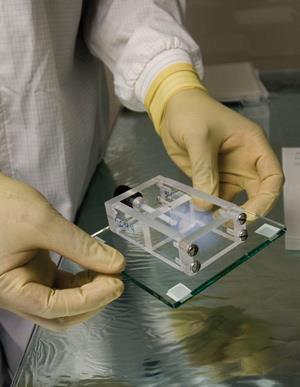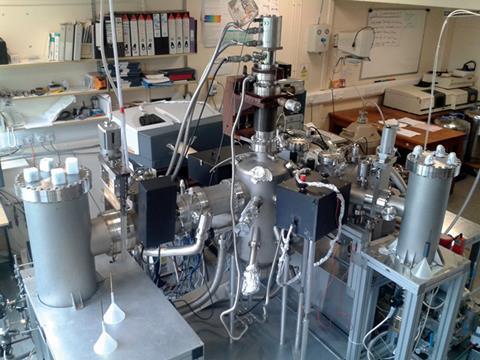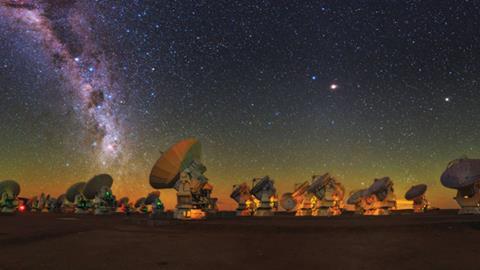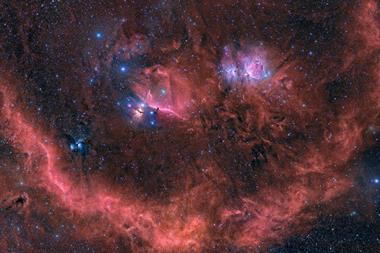Molecules in deep space are very small and very far away, as Matthew Gunther discovers
History tells us countless stories of philosophers and scientists who looked to the heavens and were awestruck by the majesty of the stars. Francis Bacon, the 16th century philosopher, was one such figure. He raised many questions about the nature of the stars such as whether their substance ‘be of a solid or flamy nature’. But his curiosity was not just drawn towards the light of the ‘heavenly bodies’; he was also fascinated by the darkness between them. What is buried within the eternal darkness of interstellar space?
At first glance, the answer may not be as alluring as the light that surrounds it. ‘Dust is the bane of an astronomer’s life,’ laments Helen Fraser, an astrochemist from the Open University, UK. ‘It’s all over the place!’ Rather than being an inert nuisance in your house, dust, along with giant, diffuse clouds of gas, is very much the key to unlocking how stars are born.
In interstellar space, these dusty clouds of gas slowly come together under high pressure and low temperatures to kickstart the star formation process through chemistry. Molecules begin to form, but it’s a wonder anything happens at all. ‘High pressure means maybe a few thousand atoms, molecules or ions per cubic centimetre. On Earth, you have about 1018 molecules per cubic centimetre,’ explains Fraser. With so few molecules in any given volume of space, Fraser believes it raises a question that sums up the whole field: how does chemistry happen if there aren’t many atoms or molecules around?
Barrier to entry
Astrochemists are attempting to answer this question. But given the scarcity of complex molecules in space, there are only more questions to fill the interstellar void. ‘First of all, they’re not going to meet very often,’ says Fraser. When molecules do meet, there is no atmosphere to support a reaction and carry any excess energy away – the deep expanse of space does not allow for the common three-body collisions taking place in our own atmosphere.
In interstellar space, you can’t form molecular hydrogen by a gas-phase route
Many molecules therefore form through ‘barrierless reactions’, forgoing the need to overcome an energy barrier. ‘So that means ion–neutral reactions, radical–radical reactions, neutral–radical reactions – some quite exotic reactions involving photons and electrons such as dissociative electron attachment, radiative attachment,’ says Fraser. ‘All these kinds of weird and wonderful processes are very much formed in gas-phase chemistry.’
But what of the molecules that are the precursors to life on our own planet, such as water, molecular hydrogen and other complex organic molecules, which can only form through the ebb and flow of energetic reactions? ‘Under the conditions you have in interstellar space where most stars are forming, you can’t form molecular hydrogen by a gas-phase route. We must have solid-state chemistry happening,’ Fraser says.
Universal nanotechnology
For solid-state chemistry to take place, however, you need a surface and this is where dust takes centre stage. ‘[Dust] is both a nucleation seed and a heterogeneous catalysis surface,’ says Fraser. ‘It’s a type of universal nanotechnology.’
About 30 times smaller than the diameter of a human hair, these dust particles are formed from the ‘outflows of dying stars’. But, considering dust appears to be ubiquitous in space, our understanding of it remains rather limited.
Older space probes – such as Ulysses, a joint Nasa–European Space Agency venture, and Nasa’s decommissioned Galileo– were able to establish dust’s abundance in interstellar space but it has only been recently that astrochemists have been able to truly probe the composition of these nucleation seeds.
‘If you try and get an honest opinion from an astronomer on what a dust grain is, then you probably will get as many answers as the number of people you ask,’ explains Martin McCoustra from Heriot–Watt University in Edinburgh, UK, and a former colleague of Fraser. ‘Part of the problem is that we’ve only recently got hold of a few interstellar grains from [Nasa’s] Stardust mission.’

The Stardust space probe’s interstellar dust collector (SIDC) was able to collect several interstellar particulates in an extremely light gel known as a silica aerogel – a material where a gas is dispersed through solid silicon dioxide, resembling ‘solid smoke’. Due to its ultra-low density, the gel was able to capture these high-speed particles like a fly in a spider’s web, without damaging their internal structure.

Since returning to Earth in 2006, laboratory researchers have been painstakingly sifting through all of the aerogel samples to identify possible tracks of dust. So far, they’ve found only seven particles, but astrochemists have gleaned crucial information from these very rare extraterrestrial artefacts after trapping them in silicon nitride aerogels. Through a combination of analytical techniques, including x-ray diffraction and scanning transmission x-ray spectroscopy, Nasa were able to pinpoint the chemical structure of these dust grains.
Much to their surprise, interstellar dust is chemically diverse. Initially thought to be wholly made up of carbonaceous or graphitic material, the amorphous grains also appear to be rich in silicates. The particles contained an olivine ((Mg,Fe)2 SiO4) core surrounded by magnesium silicates – olivine being a mineral important in rock formation here on Earth.
This isn’t set in stone, however. Much is still to be learnt about the nature of these grains, with some research indicating the presence of another silicate mineral, pyroxene. But astrochemists are now beginning to gain a deeper understanding of what is happening on their surfaces.
A slippery surface
Before a star forms, the interstellar medium is a cold and unforgiving environment. ‘There are lots of hydrogen and oxygen atoms around,’ says Fraser. ‘The first step that happens is these atoms collide with the dust grain surface.’ But given the energy barriers involved in chemisorbing to a surface, they can only weakly adsorb to the grains.
Such a basic process only serves to illustrate how important dust is in space. ‘You bring a huge number of molecules in close proximity and, therefore, it is much easier for the molecules to react,’ Fraser said at the Royal Astronomical Society in March 2015.
The dust is catalysing H2 formation
‘You’re looking at atoms like oxygen, nitrogen, carbon, sulfur coming down on to surfaces and picking up hydrogen atoms if they can,’ explains McCoustra. ‘Effectively the grains grow an ice, which is rich in hydrogen-rich molecules.’ Hydrogen and oxygen react to form water and freeze out on the dust, while hydrogen molecules slowly form on the surface.
The creation of these ices helps to explain the presence of gaseous molecular hydrogen – probably the most abundant molecule in the universe and the lifeblood for a plethora of astronomical processes. ‘These H2 molecules have a huge exothermicity as they form and that energy is sufficient to desorb the molecules from the surface – putting [it] into the gas phase,’ explains Fraser. ‘The dust is catalysing H2 formation.’
With hydrogen molecules floating through the interstellar medium, the clouds begin to cool and carbon and oxygen react to produce carbon monoxide, which condenses on to the newly-formed interstellar ices. This leads to an icy overlayer of carbon monoxide and dioxide, according to Fraser, and is known as ‘critical freezeout’. From there, methanol may be created from the hydrogenation of carbon monoxide, along with methane and ammonia.
‘When the stars start forming, you end up with UV photons from the stars warming the ices,’ Fraser adds. This constantly evolving microscopic environment will be subjected to photodesorption and a whole host of complex molecules may be liberated from the surface.
Reach for the stars
It appears to be a simple and logical process, but how have we arrived at this interpretation? Rather than carry out risky and expensive space missions, astrochemists have reached for the stars and brought space down into the laboratory.
These astrochemical labs, many of which are in the UK, harbour a world full of cryostats and vacuum chambers, offering chemists an opportunity to find out how molecular ices behave in space. ‘The question is what happens to this very simple ice composed of diatomic and triatomic [molecules] when we irradiate it with cosmic rays and UV radiation consistent with the interstellar environment,’ explains McCoustra. ‘The goal is to really tie down what happens to the ice once it’s made.’
Like Bacon before them, astrochemists are now truly stepping into the void. McCoustra’s group, alongside others in the UK including Wendy Brown at the University of Sussex and Stephen Price at University College London, have been able to find their way through the darkness by using a number of surface analysis techniques including reflection absorption IR spectroscopy (Rairs) and temperature programmed desorption (TPD) to probe interstellar ices.
Both techniques allow astrochemists to mimic the conditions found within the interstellar medium. But you need a surface and, as the Stardust mission illustrated, interstellar dust samples are incredibly hard to come by. The team at Heriot–Watt had to create an analogue in the lab. By heating powdered silica with an electron beam, they were able to coat a stainless steel plate with amorphous silica – representing, to some extent, the microscopic hills and valleys on a speck of dust.

With a simple way of creating their very own stardust, McCoustra and his colleagues placed their precious cargo into a vacuum chamber, brought the pressure down to 10–7 mbar – still several orders of magnitude higher than that found in interstellar space – and, through the use of a ‘cold finger’, cooled the silica down to 10K. By pumping pure gases through the chamber, molecules can freeze out on the surface and grow into a molecular ice. The team often focuses its attention on a mixture of water, hydrogen cyanide, carbon monoxide and dioxide, and ammonia ices.
By firing a glancing IR beam across the ice’s surface using Rairs, the frozen surface reveals its dynamic secrets. Simple spectra detail the internal structure of the ice, giving researchers an indication as to the extent of crystallinity, and also highlight the strength of interaction between molecular species.
TPD, unlike Rairs, may not just play a purely analytical role – the technique could be seen as a direct simulation of the gentle heating of ices in interstellar space. By slowly increasing the surface temperature, McCoustra and his colleagues are able to assess the abundance of molecules being thrown into the gas phase and the energy required to break the surface bonds holding them down.
But even though these experiments appear to be simple from a scientific perspective, trying to maintain the harsh cold of the interstellar medium is still a technological challenge, according to Price. ‘Getting everything cold … is not trivial because things have a tendency to get warm,’ he explains. ‘The surface heats up from absorbing the blackbody radiation from the chamber.’
Although blackbody radiation may be an undesired problem, for which astrochemists can swiftly make adjustments, different types of radiation can be used to replicate the bombardment of cosmic rays in the interstellar environment. Only recently, the Heriot–Watt team, funded by the laboratory astrochemical surface science in Europe training network, irradiated a molecular ice made from acetonitrile (CH3 CN) with protons and witnessed not just its sublimation but also the creation of a larger set of organic molecules, including etheneimine (H2 CCNH) and cyanoacetylene (HCCCN).
Alma matter
The observation and production of such molecules in the laboratory is central to an emerging philosophy in modern astronomy – interstellar dust and their ices may be producing the seeds for the origins of life, amino acids. Some may argue that the production of amino acids, the building blocks of proteins, is exclusively a terrestrial phenomenon but astronomers are now detecting them directly in space.
Back in 2008, Arnaud Belloche and his colleagues at the Max Planck Institute for Radio Astronomy in Bonn, Germany, were one of the first groups to detect one of these compounds – amino acetonitrile. The team used the Very Large Array– a series of 27 radio antenna dishes nestled together on the Plains of San Agustin in New Mexico, US, and focused their attention on an interstellar cloud called Sagittarius B2 in the Milky Way. Separately, these 25m-diameter dishes would not be sensitive enough to detect a single molecule at a distance of 27,000 light years away. But when the incoming IR signals from each are combined, the array mimics the sensitivity of a radio telescope over 125m wide.
This same principle of radio interferometry is behind astronomy’s new ‘molecule detector’ – the Atacama large millimeter/submillimeter array (Alma) in Chile’s Atacama desert. When comparing Alma’s capacity to its predecessor, it simply leaves the Very Large Array in the dust. With 66 movable antennae, Alma can obtain images only a 14km-diameter telescope could hope to achieve.
It’s an incredible feat of engineering and one which is already proving its worth to the astrochemical community. Since Alma has come online, Belloche and his colleagues have successfully identified a branched alkyl molecule, isopropyl cyanide, in the star-forming cloud of Sagittarius B2. Such a branched structure is a key characteristic of amino acids in organic matter and Alma may open the door to many more being discovered. ‘The detection of this branched molecule was obtained with a large spectral survey,’ says Belloche. ‘There were several thousand spectral lines detected [and] the hope is that we’ll be able to find other new molecules in this data set.’
But Alma raises a greater prospect for the future – one not based on the ground-breaking science it’s producing, but the collaborations it is helping to foster. ‘We use the information we get from laboratory spectroscopists, so we know at which specific frequency each molecule should emit,’ explains Belloche. ‘With this information we can produce synthetic spectra and compare them to the observed spectrum [from Alma]. If the pattern matches what we observe, then we can be sure we have detected a molecule.’
‘That’s one of the reasons I really enjoy the field – it is really a proper collaboration,’ adds Price. ‘The astrophysicists will say to us “Will this react with this?” And the numbers you produce get used in models.’
Fraser agrees that ‘the community is growing’ but is concerned that not every astrochemist should be swept up in the hunt for the origins of life when looking at their frozen dust. ‘It’s not necessarily the primary motivation because the interesting astronomical problem is how stars and planets form,’ Fraser concludes. ‘If we can’t form stars and planets, we can’t form life.’













No comments yet